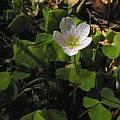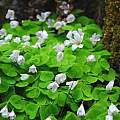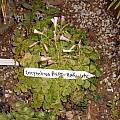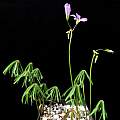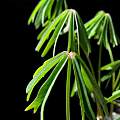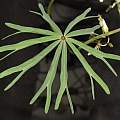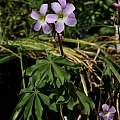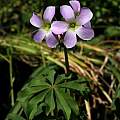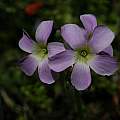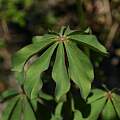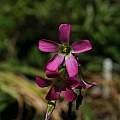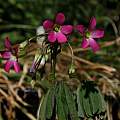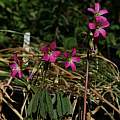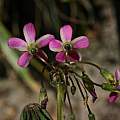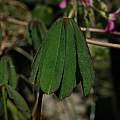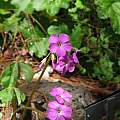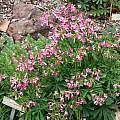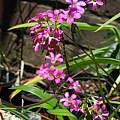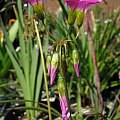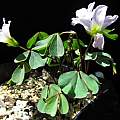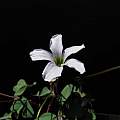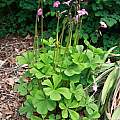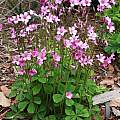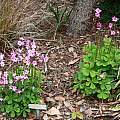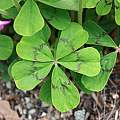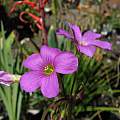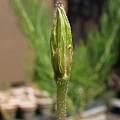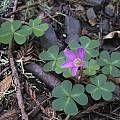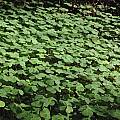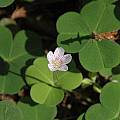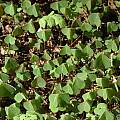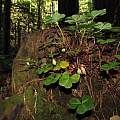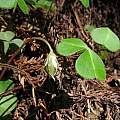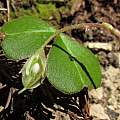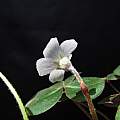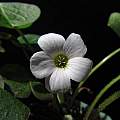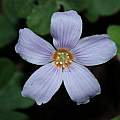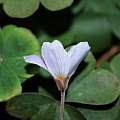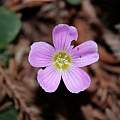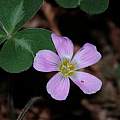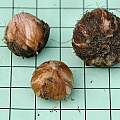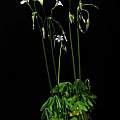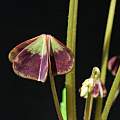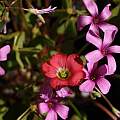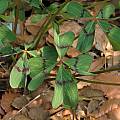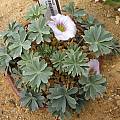Oxalis that are native to areas other than South Africa and South America are found on this wiki page.
Oxalis index - Oxalis flava - Oxalis hirta - Oxalis obtusa - Oxalis pes-caprae - Oxalis purpurea - South African oxalis A-B - South African oxalis C -South African oxalis D-E - South African oxalis F-G - South African oxalis H-K - South African oxalis L-M - South African oxalis N-O - South African oxalis P - South African oxalis R-S - South African oxalis T-Z - South American oxalis
Oxalis acetosella is native to a broad northern geographic range in Asia, Europe, North America up to 3600 m in the Himalaya. Plants are found in forested and wet shady places where it forms patches as it spreads by creeping underground stems (rhizomes). This species is the type for the genus Oxalis. It has white flowers that are pink to purple veined. Height: 8 cm. Photo 1 was taken May 2004 near Aberfeldy, Scotland by Bob Rutemoeller. Photo 2 was taken in the country of Georgia by Oron Peri. Photo 3 by Martin Bohnet shows the species folding up its leaves on an unusually hot and sunny day in April in Southern Germany. In that particular area, Oxalis acetosella grows despite the lime in the soil by colonizing dead tree stumps.
Oxalis debilis is a very cosmopolitan species, occurring in all continents except Antartica. It can be found in both temperate and tropical areas.
Oxalis debilis var. debilis is found in the Andes, but is cultivated in many areas of the world.
Oxalis debilis var. corymbosa (syn. Oxalis corymbosa) is most widespread, and found on all continents except Antartica. As a result of this, a number of cultivars have been introduced to horticulture.
'Aureoreticulata' has attractive variegated leaves with flowers that are pinkish purple. The photos below were from Ann who grew the plant from a commercial source. Photo 1 shows the plant from the first year and photo 2 shows the plant in the second year which had tripled in size.
Oxalis decaphylla is native from Mexico north to Arizona and New Mexico, USA. It is called decaphylla because a typical leaf has 10 leaflets. It is a summer-growing species and has a marked dry winter dormancy. Photos 1-3 were taken by Nhu Nguyen. Photo 4 was taken by Dylan Hannon of a different form.
Oxalis hernandezii is native to Mexico. The photos below from Nhu Nguyen show plants in cultivation.
Oxalis lasiandra is native only to Oaxaca, Mexico where it grows in shrubby foothills of Quercus-Acacia and Quercus forests between 1700-2160 m. It most closely resembles O. magnifica but the bulb scales have 15-35 nerves. Photos 1-2 by Ann who notes that the flowers and the leaves droop downward at night and then spring open in the sunlight. Photo 3 taken by Jim McKenney shows the big, juicy contractile roots which form under the bulb clusters. These roots are not storage structures and fall off or deliquesce shortly after the bulbs go into dormancy.
The photos below were taken by Nhu Nguyen of plants in cultivation.
Oxalis macrocarpa is native to Nayarit and Jalisco States, Mexico where it grows in shrubby hills, Quercus forests or cultivated fields between 1100-2300 m. The photos below were taken at the UC Botanical Garden by Nhu Nguyen.
Oxalis magnifica is native only to Oaxaca State, Mexico where it is found in shrubby Quercus zones or low Pinus-Quercus forests between 1850-2200 m. It is thought to be the intermediate form between O. nelsonii and O. lasiandra. The plants are summer growing and winter dormant. Dormancy is triggered by temperature and not water availability in cultivation. Photos 1-2 were contributed by the UC Botanical Garden and photos 3-6 were taken by Nhu Nguyen.
Oxalis morelosii is native to a small area of Morelia, Michoancán, Mexico where it grows in shaded wet slopes in an oak forest. Because of the narrow distribution, this species is threatened by habitat loss. The species was described in 2009. The photos below are from Nhu Nguyen of a living division of the holotype plant. It behaves like other Mexican Oxalis with moist summers and a completely dry winter.
Oxalis nelsonii is native to southern Mexico, particularly Oaxaca and Chiapas states and south to Honduras. Plants are found in cultivated fields, shrubby foothills or forest of Quercus or Pinus-Quercus between 1700-2510 m. This species has leaves with 3-6 leaflets. It is very closely related to O. magnifica, O. lasiandra, and O. tetraphylla and it can be very difficult to tell them apart.
The photos below were contributed by the UC Botanical Garden.
The photos below were taken by Nhu Nguyen that shows various aspects of the species. Photo 5 shows the pod that is near maturity. Photo 6 shows the very thick contractile root typical of many bulbous Oxalis.
Oxalis oregana native from California to Washington where it is found in moist and shady redwood forests. In certain areas it can grow as a ground-cover forming great carpets. The plants spread through thickened rhizomes or through large seeds. In more moist places, it can grow as an epiphyte on redwood stumps. Height range: 5-15 cm. The coastal redwood forests are mild in temperature and are moist year-round. In the winter, the precipitation comes from rain and in the summer, the precipitation comes from fog drip. This plant can be grown in cultivation if given a rich, and well-draining mix, and consistent watering.
The photos below were taken by Bob Rutemoeller. The first photo was taken in Kruse Rhododendron State Park in northern California. Other photos taken in another state park with a redwood forest show the mass of flowers, a flower that is white with pink veins, and a group with folded leaves.
Photos from Nhu Nguyen show various forms of the species. Photos 1-3 were taken in Mendocino County and show an epiphytic plant with seed pods and the seed pods and seeds ready to explode from the pod.
Photos from Nhu Nguyen show various forms of the species in cultivation.
Oxalis sp. This Oxalis was collected in Oaxaca, Mexico. It is summer growing and blooming. The first photo was taken by Bob Rutemoeller. The second by Mary Sue Ittner shows the bulbs on a 1 cm grid. It is in the O. magnifica/lasiandra/nelsonii group.
The photos below from Nhu Nguyen are of an unidentified species from Durango, Mexico. These produce small bulbs but the plants are larger and vigorous.
Oxalis tetraphylla Cav. is native to central Mexico and also reported in Panama. You can often find this species sold under the name Oxalis deppei. There are three varieties which can be separated by the number of nerves on the bulb scales. This is one of the most common Mexican species in cultivation because of the mass marketing of the variety 'Iron Cross'. Other forms typically are found in botanical gardens worldwide but are not often seen in cultivation. The photos below were taken by Nhu Nguyen seed-grown plants originally from Guerrero, Mexico. It has purple-pink flowers, which are different than the ones more common cultivation. These plants all exhibited slightly different leaf morphology, even though they were from the same batch of seeds.
Oxalis tetraphylla 'Iron Cross' is the most commonly grown form of this species. This form has flower colors that are more carmine-salmon-red. Photo 1 was taken by Bill Dijk. Photo 2-3 was taken by Nhu Nguyen. The last photo from Janos Agoston shows the storage organs with the rhizome that is produced when in growth.
Oxalis tetraphylla 'Reverse Iron Cross' is another form in cultivation that only has a band of maroon across the leaflets. The flower color is the same as the 'Iron Cross' cultivar. Photos were taken by Nhu Nguyen. Photos 1-3 were taken of plants obtained from cultivation. Photo 3 shows the plant with O. articulata. Photo 4 was taken at the UC Botanical Garden of a wild clone, which looks like this cultivar.
Oxalis 'Ute' This plant was blooming in the Alpine House at Wisley Gardens in the U.K. in May 2004. Photo by Bob Rutemoeller.
Oxalis index - Oxalis flava - Oxalis hirta - Oxalis obtusa - Oxalis pes-caprae - Oxalis purpurea - South African oxalis A-B - South African oxalis C -South African oxalis D-E - South African oxalis F-G - South African oxalis H-K - South African oxalis L-M - South African oxalis N-O - South African oxalis P - South African oxalis R-S - South African oxalis T-Z - South American oxalis
